Kosovo is no longer a ‘special case’ in international law: the case of Donbass
In
Log in if you are already registered
Russian President Vladimir Putin affirms that the special military operation in Ukraine is compliant with international law. He says that Russia is legally providing military assistance to Donetsk and Lugansk People’s Republics.
In my previous article, I explained that in order to win his legal argument, Putin can show that Donetsk and Lugansk republics belong to the same category as Kosovo for statehood rights, assuming the “special case” for Kosovo independence, made by the US Department of State, and other Putin critics.
So let’s compare Kosovo and Donbass events:

Death Toll
- Kosovo
13,517 people killed or went missing from January 1998 to December 31, 2000
- Donbass
14,200–14,400 people killed from April 14, 2014 to December 31, 2021
Refugees
- Kosovo
1.5 Million people, 90% of the population
- Donbass
1.6 Million people registered as internally displaced in Ukraine + 1 Million abroad, mostly in Russia. 40% of the population
Agression against their own people
- Kosovo
Empty villages attacked.
- Donbass
On April 7, 2014, an “Anti-Terrorist Operation” against “Russia’s invasion” is launched by Alexey Turchynov, chief of the Security Service of Ukraine, and unelected president by interim.
Massacre with significant impact
- Kosovo
45 deaths in Racak village, on January 15, 1999:
Moral outrage in the White House, paving the way for NATO military operation.
Two contradictory reports, one by a Yugoslav-Belarus forensic team and another by a EU-Finnish team.
No evidence about Racak massacre was ever presented at the ICTY, in order to “improve the expeditiousness of the proceedings while ensuring that they remain fair”.
A decade later, in her biography, Finnish forensic Helena Ranta confessed that Finnish Foreign Ministry official Pertti Torstila, and OSCE William Walker, tried to influence her report.
- Donbass
48 deaths in Odessa syndicate building, on May 2, 2014.
Moral outrage in Donetsk, encouraging self-determination.
Tribunals in Ukraine still didn’t address this event.
Rejection of peace
- Kosovo
Following the Racak massacre, peace talks are held in Rambouillet, Paris region. Serbian President Slobodan Milosevic refuses to sign the Rambouillet peace agreement with Kosovo separatists, and as a consequence, NATO launches “Operation Allied Force”, an aerial bombing campaign on the whole territory of Serbia.
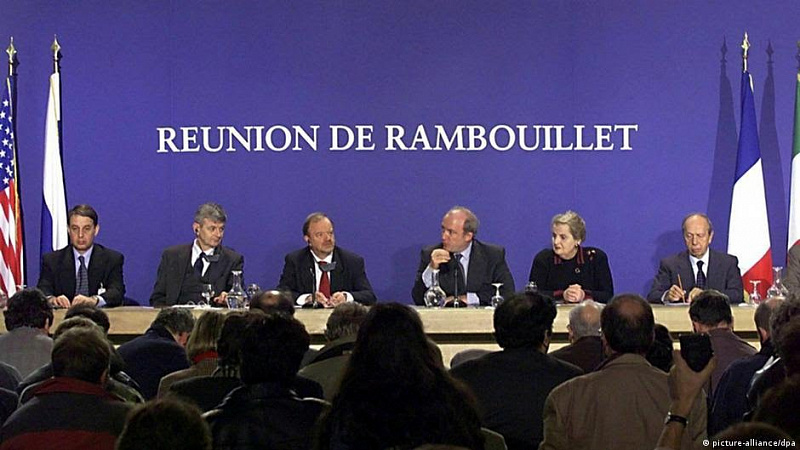
- Donbass
On October 1, 2019, Ukrainian President Vladimir Zelensky officially agrees on the “Steinmeier formula” for implementing the 2015 Minsk peace agreement.
Zelensky’s oppositions, including former President Petro Poroshenko and Azov battalion, refuse “Steinmeier formula”, calling it a “capitulation”. They start protests in front of Zelensky’s office.
Zelensky capitulates to their demands, despite having won elections in April 2019 with 73% of votes, on the the war in Donbass:
On 28 October 2020, ATO veteran Alexey Arestovych becomes official speaker of the Ukrainian delegation to the TCG at Minsk talks, and later he becomes advisor to the Head of the Office of the President of Ukraine.
On 11 August 2021, Arestovych explains that “there’s nothing wrong with Steinmeier formula, but there is a fourth point that has not been implemented by Russia since September 2014: a ceasefire, a withdrawal of troops, the withdrawal of all foreign troops and the disarmament of illegal armed groups. It will not be fulfilled, no need to worry”, echoing the US official position by Kurt Volker.
In March 2019, Arestovych described ATO (the “Anti-Terrorist Operation” in Donbass) as a Cossack-themed “holiday resort”:
In a self-fulfilling prophecy, Arestovych predicted an armed conflict with Russia “with a probability of 99.9%”.
And this conflict won’t stop until 2035.
In the meantime, Donbass children living on the front line “just want this war to end”:
as Ukraine was steadily growing military spending and NATO interoperability:
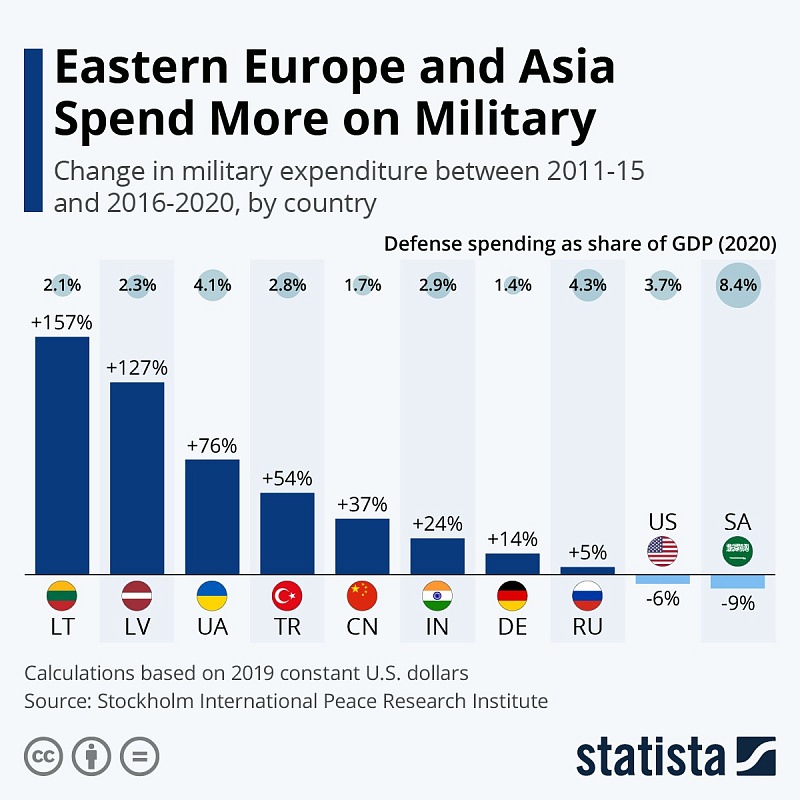
Ukraine’s commitment to the Minsk peace agreement is blatantly missing from the above list of “Ukraine’s contributions to Transatlantic security” compiled by the “New Europe Center”; although this agreement was brokered by NATO members and EU co-founders Germany and France.
After the launch of the Russian “special military operation”, some Zelensky voters in Mariupol voiced their disappointment about his failed promises.
Nationalistic leaders
- Kosovo
Serbian President Slobodan Milosevic in Gazimestan speech in 1989: “Six centuries later [after the battle of Kosovo], now, we are being again engaged in battles and are facing battles. They are not armed battles, although such things cannot be excluded yet.”
- Donbass
Ukrainian President Petro Poroshenko in 2014: “their children will hole up in the basements”
Azov’s first combatant Andrey Biletsky, on 5 February 2022: “we have fun killing”.
Foreign intervention
- Kosovo
On 24 March 1999, US President Bill Clinton launches an openly illegal NATO military operation:
In his declaration, Bill Clinton completely ignores international law.
- Donbass
According to Vladimir Putin, there are Russian volunteers with military experience, but the regular Russian army isn’t involved as such:
Genocide legacy
- Kosovo
4 years before the 1999 NATO military operation in Kosovo, a genocide happened in Bosnia and Herzegovina, according to the ICTY and the ICJ, and in particular, the Srebrenica massacre of 1995:
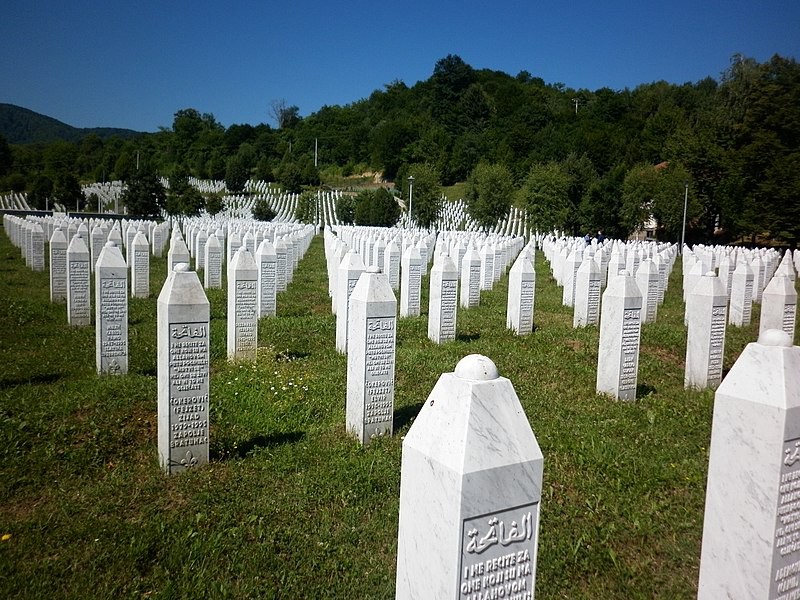
- Donbass
63 years before the 2014 Donbass war, the Holocaust genocide happened in Ukraine.
For example, the Lviv Pogrom of 1941.
Jews weren’t massacred simply because they were Jews, but because “the Jews in the USSR constitute the most faithful support of the ruling Bolshevik regime, and the vanguard of Muscovite imperialism in Ukraine”, according to the Organization of Ukrainian Nationalists.
With the Euromaidan, OUN supporters gained more visibility:
In 2015, Ukraine adopted the law “On the Legal Status and Honoring the Memory of Fighters for Ukraine’s Independence in the Twentieth Century”, making illegal to “publicly show contempt” for the OUN.
In accordance with this law, I am not taking any stance on the controversial debate whether the OUN participated in the Lviv Pogrom.
Even Vladimir Zelensky, despite his Jewish roots, can’t distance himself from this new legally sanctioned narrative.
By anticipating an extension of this law to 21st century fighters, I will simply present this video explaining the absence of connection between Azov battalion logo and the Nazi SS Wolfsangel.
Intent to transform the ethnic identity of a territory
According to article 2 of the Genocide Convention, a genocide is an intent to destroy, in whole or in part, a national, ethnical, racial or religious group. This would not be the best designation for either Serbian or Ukrainian nationalist projects, in Kosovo and Donbass, but there is still some similarity.
- Kosovo: ethnic cleansing
According to German Defense Minister Rudolf Scharping, Serbia had an ethnic cleansing plan called “Potkova [horseshoe] Plan” :
“The clear objective of the Horseshoe plan is to clean ethnically the whole of Kosovo and to deport the whole civilian population. Operation Horseshoe was planned in Belgrade by the military staffs, by Milosevic and his regime (…) It started during Rambouillet and during the negotiations in France, and it was intensified after the negotiations”
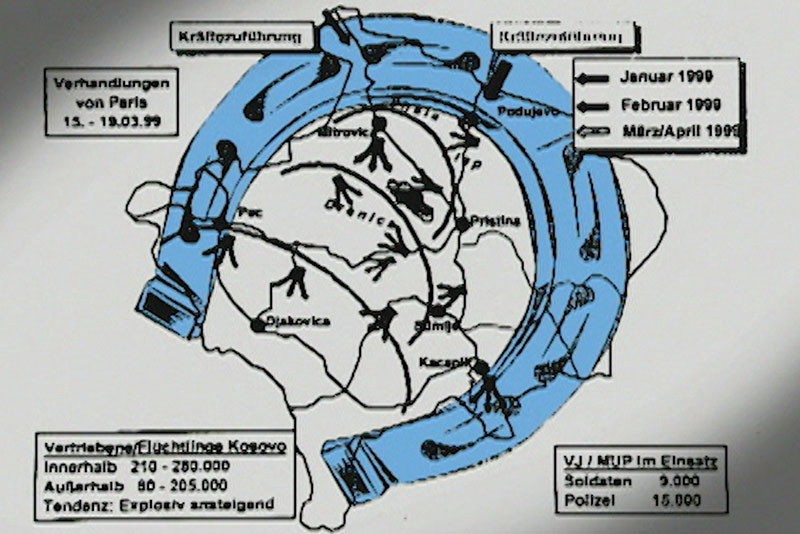
This ethnic cleansing plan was never published anywhere, and at his ICTY trial, Milosevic denied it.
However, ICTY judge Iain Bonomy still concluded: “It was the deliberate actions of these forces during this campaign that caused the departure of at least 700,000 Kosovo Albanians from Kosovo in the short period of time between the end of March and beginning of June 1999”
- Donbass: derussification
Derussification is not the simple promotion of Ukrainian language. It’s a state-sanctioned project of transformation of the Ukrainian identity, of what it means to be Ukrainian. It’s the cleansing of the Russian and Soviet elements in the Ukrainian identity.
A symbol of this project is the iconic encounter of a Ukrainian soldier with a grandma holding a Soviet flag:
Following the 2016 law of Ukraine “On condemnation of communist and National Socialist (Nazi) totalitarian regimes in Ukraine and ban on propaganda of their symbols”, more than 51,493 streets were renamed, as well as 3% of cities and villages.
For example, among them, the city of Stakhanov, in Lugansk region, named after Alexey Stakhanov, a Donbass coal miner with legendary productivity. A migrant worker from Russia, he inspired the Stakhanov labor movement across all the Soviet Union, and achieved world fame:
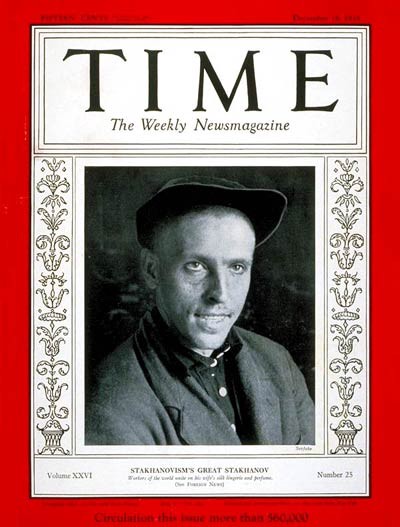
Heroes of socialist labor like Stakhanov have no place in the new “glory of Ukraine”, and are replaced by OUN heroes such as Stepan Bandera, Roman Shukhevych and Dmytro Klyachkivsky, who achieved legendary productivity in a completely different domain, during the Second World War.
Education is another field where the Ukrainian identity is being rewired. It’s not only about “children camps” by state-sponsored Azov battalion.
It’s also about mainstream education, in public schools. For example, the 8th grade geography book by Petro Maslyak, published in 2016:
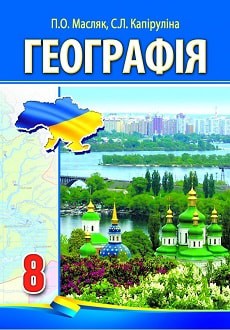
The book teaches that “closeness of language does not always mean the closeness of the genetic origin of peoples or even their race.” For example, Ukrainians are “Slavicized Germans”, while Russians are “Finno-Ugric”. When the book made a scandal, Maslyak denounced “Muscovites and their fifth column in Ukraine.”
Names of cities, and school books, would be anecdotal, if they didn’t participate in a systemic pattern of othering of the Russian identity, with implications for the peace process.
Arestovych and his American mentor didn’t want to apply the peace agreement until “Russian forces” withdrew from Donbass. But why did they insist on withdrawal, instead of inclusion into the Ukrainian army?
Why could the Azov battalion be so easily integrated into the Armed Forces of Ukraine, but not the Somali battalion?
(by the way, since Azov’s logo isn’t a German Nazi symbol, then Somali’s logo isn’t a Russian Empire symbol, after all. It’s actually a symbol dating back to several ancient civilizations. For example, the double-headed eagle can be found on the sphinx gate at Alacahöyük, an archeological site in Anatolia)
A distribution of Ukrainian passports to DNR/LNR fighters of any origin would have been the simplest solution.
Donetsk and Lugansk People’s Republics could even have been granted autonomy in immigration policy, like Quebec within Canada. As part of their “special status”, they could have had their own Ministries of Immigration, Russification and Integration, like Quebec has a Ministry of Immigration, Francisation and Integration.
All Somali battalion fighters would have received Ukrainian passports as gifts, in recognition of their fight for Ukrainian values of pluralism, multiculturalism, and federalism. After all, Zelensky’s election slogan was: “Ukraine — It’s you!”
If Zelensky’s slogan wasn’t a joke, then why didn’t he seriously proclaim: “Ukraine — It’s Givi and Motorola” ?
Kiev central authorities can give away Ukrainian passports very liberally, when it fits their political agenda. For example, Petro Poroshenko offered a Ukrainian passport to his former classmate Mikhail Saakashvili. So why Donetsk and Lugansk authorities could not offer Ukrainian passports to their Russian friends?
This inclusive solution was inconceivable for Alexey Arestovych and Kurt Volker, because their ethno-political project was to purify the Ukrainian identity of its Russian component. Shipping passport printers to Donetsk and Lugansk was a capitulation from this perspective. This generosity would have strengthened the “Muscovite fifth column in Ukraine”.
Instead, the solution proposed by Arestovych was to wage war until 2035, and the solution proposed by Azov battalion was a US-sponsored counter-insurgency operation, modeled after the ‘surge’ military operation in Iraq. Vladimir Zelensky was naively thinking that his North American instructors were transforming Ukraine into a new Canada, but all they were preparing for Ukraine was a new Iraq.
Conclusion: absolute territorial integrity can be the solution
Challenged to draw a legally relevant distinction between Kosovo and Donbass, Putin critics could choose to avoid this controversy altogether, and instead affirm the “principle of absolute respect for the sovereignty and territorial integrity of all states”, like Ukraine did in 2010 about Kosovo. Rejecting all “special cases” might be the most reasonable option, all things considered.
That will still be a personal victory for Vladimir Putin, who is fighting for the principle of territorial integrity since the Chechnya war. Putin himself did not recognize Kosovo, but is using it as a premise for a proof by contradiction, a reductio ad absurdum.
That can have far-reaching consequences. Kosovo is currently recognized by 50% of UN members:
Moreover, the recognition of the Republic of Crimea by the Russian Federation, on 17 March 2014, could also be affected.
At the end, this legal pathway can lead to a principled settlement of the situations in Ukraine, Kosovo, Taiwan, and other disputed territories.




